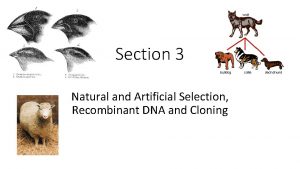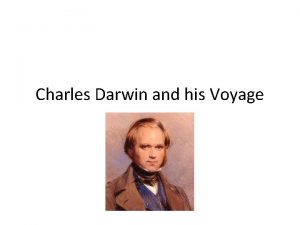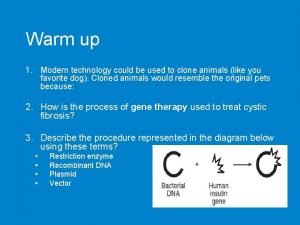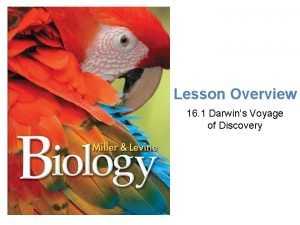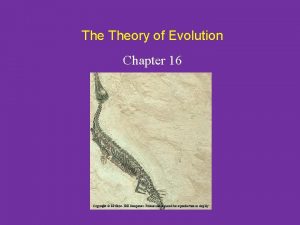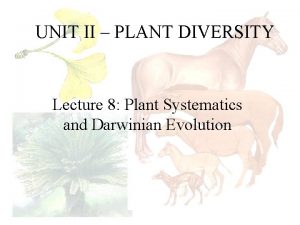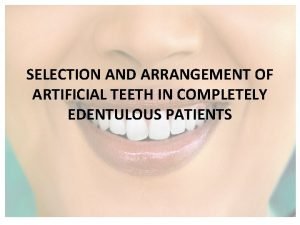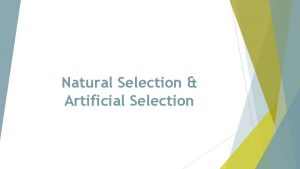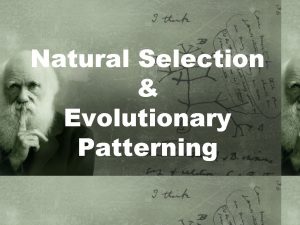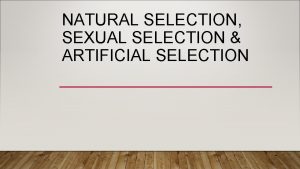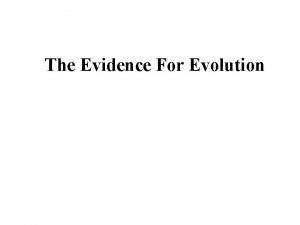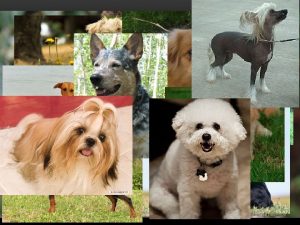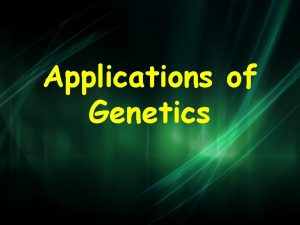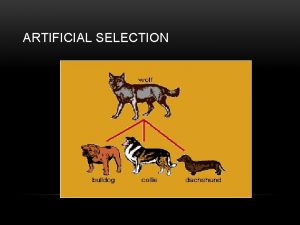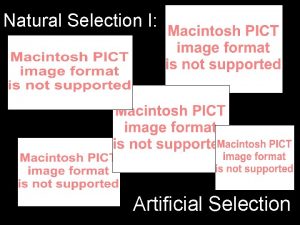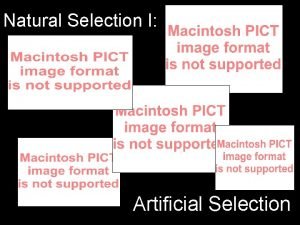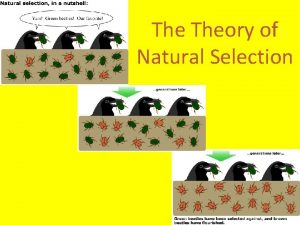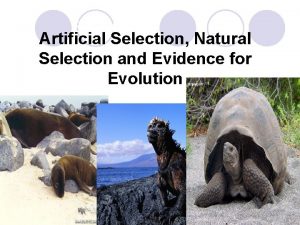NATURAL VS ARTIFICIAL SELECTION NATURAL SELECTION Natural selection














- Slides: 14

NATURAL VS. ARTIFICIAL SELECTION

NATURAL SELECTION Natural selection: the process by which individuals that are better adapted to their environment are more likely to survive and reproduce than other members of the same species. Key elements: Overproduction-many off-spring because few will survive Variation-differences between individuals of the same species (genes and alleles) Competition-limited resources & predation (indirect) Environmental Changes

ARTIFICIAL SELECTION Artificial Selection: Human involvement develops changes in species or new species. Methods: Selective breeding-selecting organisms with desired traits to be the parents of the next generation Inbreeding-involves crossing 2 individuals that have similar characteristics Hybridization-breeders cross 2 genetically different individuals hoping to produce an organism with the best traits Cloning-DNA is taking from one organism and used to create a copy of the organism-in plants, pieces can be used to grow new plants Genetic Engineering-genes from one organism are transferred into the DNA of another organism

REQUIREMENTS OF SELECTIVE BREADING OR ARTIFICIAL SELECTION: V. I. S. T.

INTRODUCTION TO THE HISTORY OF DOGSSELECTIVE BREEDING: DOGS Origins of the Modern Dog

WHY ARE THERE SO MANY DIFFERENT TYPES OF DOGS? Do you have a dog? What type of dog do you have? Why was your breed of dog created? http: //www. dogbreedinfo. com/hybriddog/mixdesignerdogsg. htm

*DOGS ARE ABLE TO MATE WITH DIFFERENT BREEDS BECAUSE THEY ARE ALL FROM THE SAME SPECIES.

DOG BREEDING EXAMPLE WHICH DOG WOULD YOU SELECTIVELY BREED TO PRODUCE OFFSPRING THAT WOULD BE MOST EFFECTIVE IN SCARING AWAY A POLAR BEAR?

-Pointed ears are best for hearing -A loud bark will travel a longer distance -Long fur will help the dog stay warmer out in the cold -Breed 1 or 3 would probably be best -Which traits aren’t so important?

PART 1 - THE TASK You are dog breeders. You have been contacted by a scientist who wants dogs that could be used to see and retrieve waterfowl (ducks/geese) from lakes in the area. The birds are to be tagged and released. The birds are very skittish (scare easily) and must be retrieved unharmed and with a minimum amount of stress.

PART 2 -PICK DESIRED FEATURES For each feature, circle the desired form you want your dogs to have. For unimportant features, circle “any”.

PART 3 -PICK THE PARENTS Choose 2 different breeds that will be the parent dogs. Use the desired traits you chose in part 2 to help you find the best 2 parents for your skill/job. Complete the other 2 questions on your paper. Why did you choose these two parents? Are there any traits that all of their puppies will have?

PART 4 -DETERMINE PUPPY TRAITS Your cross will produce 3 puppies. You will flip a coin to determine which trait each puppy will get. Heads=mom’s feature for that trait Tails=dad’s feature for that trait For each of the remaining traits (not the 4 that we already flipped for), you will flip the coin to determine which trait will be inherited for each puppy. Examples: If you flip a heads for Smell, Puppy 1 will inherit Smell from “Mom. ” If you flip a tails for Smell, Puppy 1 will inherit Smell from “Dad. ” You will do a new flip for each trait for each puppy. When you are determining the outcomes for the traits that can blend, DD and RR will be blends. DR will show the dominant trait. Record the results in the chart.

PART 5 -OUR BEST PUPPY Choose 1 puppy that is best suited for its skill/job and draw a picture of him/her below. Then, list its traits in the other box. Your picture should show ALL the traits about that puppy. YES…your picture should be colored!!
 Natural selection vs artificial selection
Natural selection vs artificial selection Natural selection vs artificial selection
Natural selection vs artificial selection Artificial selection vs natural selection
Artificial selection vs natural selection Disruption selection
Disruption selection Artificial selection vs natural selection
Artificial selection vs natural selection Artificial selection
Artificial selection Artificial selection
Artificial selection Artificial selection
Artificial selection Why is artificial selection used
Why is artificial selection used Artificial selection
Artificial selection Artificial selection
Artificial selection What is an example of artificial selection
What is an example of artificial selection Figure 19
Figure 19 Artificial selection
Artificial selection Dentogenic concept of teeth selection
Dentogenic concept of teeth selection





